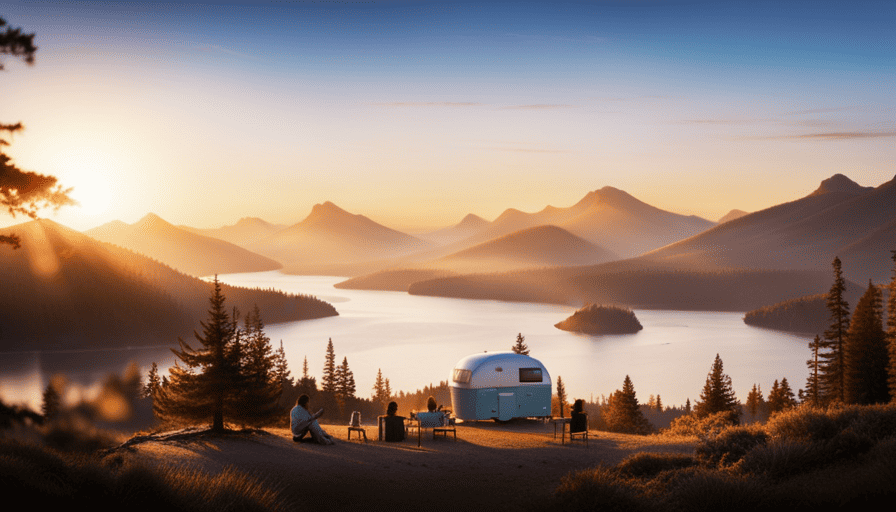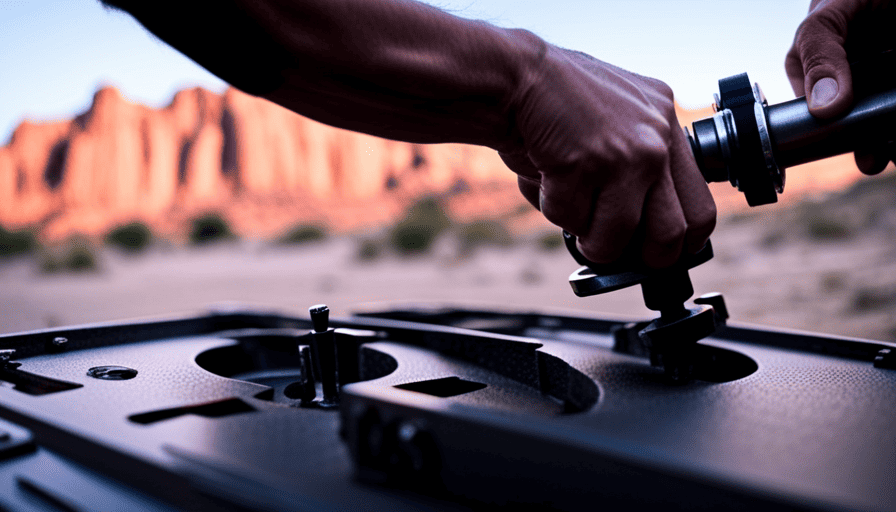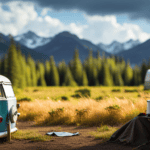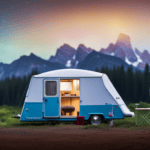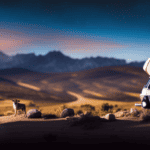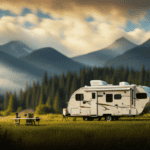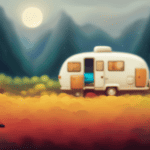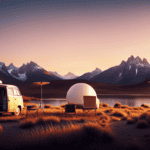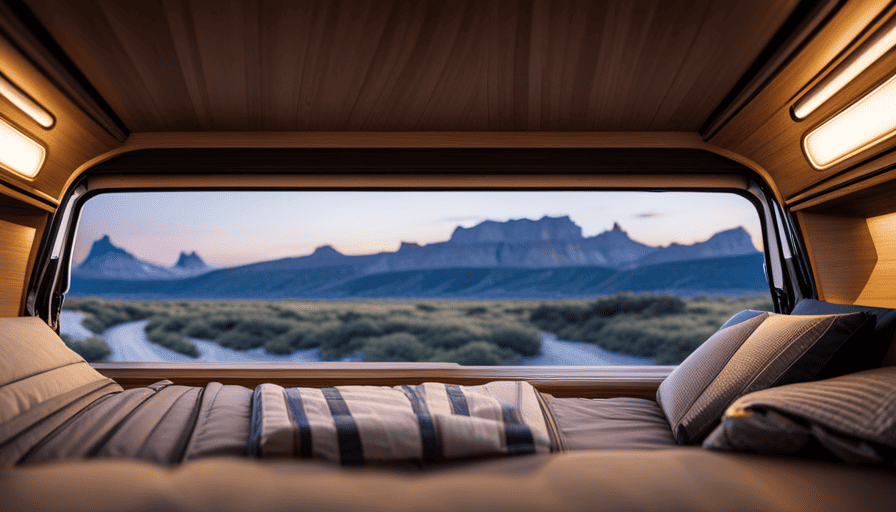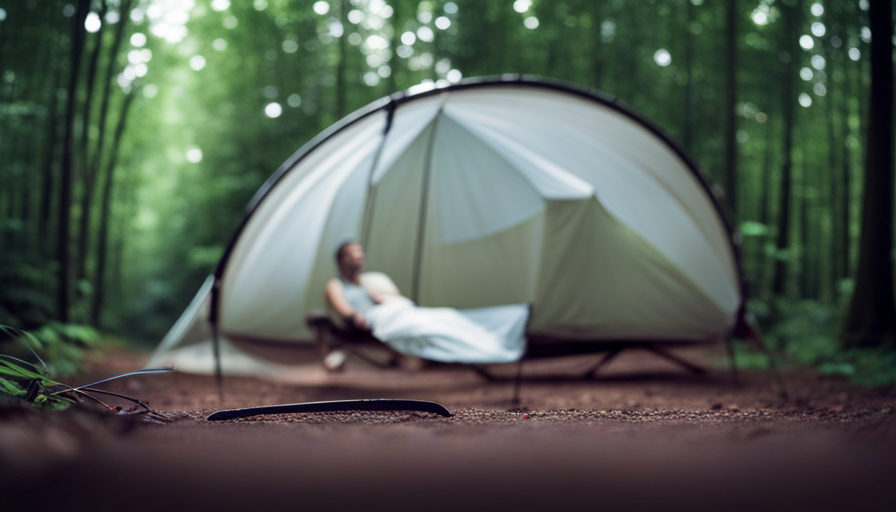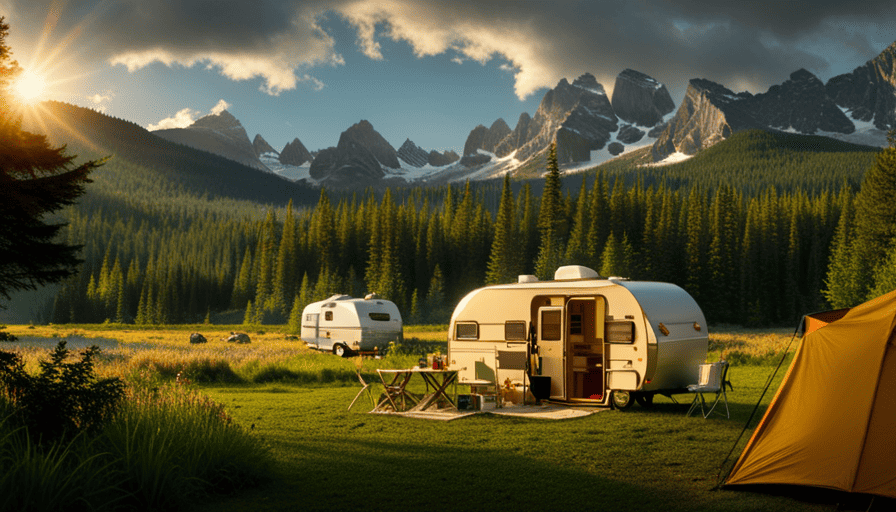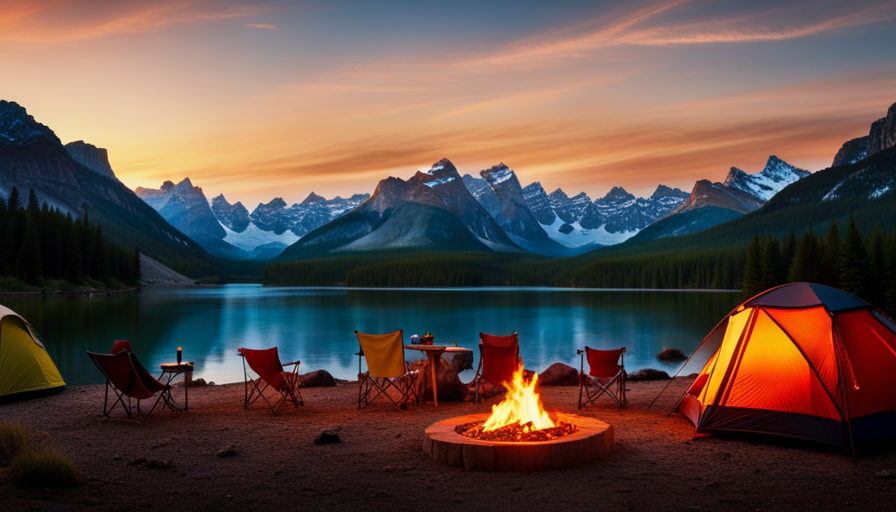Ironically, my passion for camping and my requirement to stay connected converged when I discovered that I was in need of WiFi in my camper.
As a tech-savvy adventurer, I understand the importance of having internet access on the go, whether it’s for work, entertainment, or staying connected with loved ones.
In this article, I will share my knowledge and experiences on how to get WiFi in a camper, so you can enjoy the best of both worlds – nature’s beauty and the digital world.
First, we will explore the different options available for internet access, including boosting WiFi signals, utilizing public networks, investing in a cellular data plan, and using portable satellite internet systems.
Additionally, I will guide you on how to maximize your data usage, stay safe and secure online, and even enhance your WiFi range with extenders and signal boosters.
So, if you’re ready to embark on your next camping adventure without sacrificing your internet connection, let’s dive in and discover the best ways to get WiFi in your camper!
Key Takeaways
- There are multiple options for getting WiFi in a camper, including boosting WiFi signals, using public networks, investing in a cellular data plan, or using portable satellite internet systems.
- Maximizing data usage, staying safe and secure online, and enhancing WiFi range can be achieved by using extenders and signal boosters, utilizing campgrounds and RV parks for WiFi access, using smartphone hotspots cautiously, and using portable internet solutions with external antennas.
- Public WiFi networks can be utilized in locations like libraries, coffee shops, and RV parks, but reliability and access restrictions can be limitations. Investing in WiFi boosters or extenders can improve range and signal strength.
- Backup options for WiFi in a camper include a cellular data plan, which offers convenience, speed, and reliability, and portable satellite internet systems, which offer portability, easy setup, multiple device connectivity, and pay-as-you-go options.
Understand Your Options for Internet Access
Ready to hit the road? Let’s dive into all the ways you can get Wi-Fi access in your camper!
When it comes to staying connected on your adventures, there are a few options to consider. One option is to rely on campgrounds or RV parks that offer Wi-Fi access. While this can be convenient, the signal strength and reliability can vary greatly from one place to another.
Another option is to use your smartphone as a mobile hotspot. Most modern smartphones have this capability, allowing you to connect your devices to the internet using your cellular data. However, keep in mind that this can quickly eat up your data plan if you’re not careful.
If you’re looking for a more reliable solution, you may want to consider portable internet solutions. These devices work by boosting the Wi-Fi signal in your camper, allowing you to connect to the internet even in remote areas. They often come with external antennas, which help improve the signal strength and range. This way, you can stay connected wherever you go.
Now, let’s explore how you can boost the Wi-Fi signal in your camper.
Boosting WiFi Signal in Your Camper
Enhance your connection to the digital world while on the road by effortlessly boosting the signal strength of your wireless internet in your cozy home on wheels.
When it comes to improving your wifi connection in a camper, there are a few options to consider.
One option is to invest in a wifi booster or range extender. These devices work by amplifying the existing wifi signal, allowing you to access the internet from a greater distance.
Another option is to use a high-gain external antenna. These antennas can be mounted on the roof of your camper and can significantly improve your wifi reception.
Additionally, you can position your camper closer to the source of the wifi signal, such as a campground’s wifi hotspot, to ensure a stronger connection.
Finally, consider using a wifi analyzer app to identify and avoid crowded wifi channels, which can help improve your overall wifi performance.
By boosting your wifi signal, you can enjoy a more reliable and faster internet connection while on the road.
To further enhance your internet access, you can also utilize public wifi networks available at various locations.
Utilize Public WiFi Networks
Make the most of your time on the road by taking advantage of public WiFi networks available at various locations, giving you the opportunity to stay connected wherever you go.
While public WiFi can be a convenient option for getting WiFi in your camper, it does come with some limitations. One of the main limitations is the reliability of the connection. Public WiFi networks can be crowded and overloaded, leading to slow speeds and intermittent connectivity. Additionally, some public WiFi networks may have restrictions on the types of websites or services you can access, which can be frustrating if you rely on certain apps or platforms for work or entertainment.
To find reliable public WiFi, it’s helpful to do some research before hitting the road. Look for locations such as libraries, coffee shops, or RV parks that offer free or low-cost WiFi specifically for campers. These places are more likely to have a dedicated network that is designed to handle a larger number of users and provide a more stable connection.
Additionally, consider investing in a WiFi booster or extender to improve the range and signal strength of the public WiFi networks you come across.
Transitioning into the subsequent section about investing in a cellular data plan, it’s important to note that while public WiFi can be a great option, it’s not always reliable or available. That’s why it’s also beneficial to have a backup plan, such as a cellular data plan, to ensure you have internet access no matter where you are.
Invest in a Cellular Data Plan
Having a cellular data plan is essential for staying connected on the road, allowing you to access the internet wherever you go. For example, imagine you’re traveling through a remote area and need to check your email for an important work update; with a cellular data plan, you can easily connect to the internet and stay productive.
Unlike relying solely on public WiFi networks, which may not always be available or reliable, a cellular data plan provides a dedicated connection to the internet through your mobile network provider.
One of the main advantages of a cellular data plan is its convenience. You don’t have to rely on finding a public WiFi network or dealing with slow and unreliable connections. With a data plan, you can access the internet whenever you need it, whether you’re in a bustling city or in the middle of nowhere.
Another advantage is the speed and reliability that cellular data offers. Public WiFi networks can sometimes be slow and congested, especially in popular tourist areas. With a cellular data plan, you can enjoy faster and more consistent internet speeds, ensuring a seamless online experience.
Next, I will discuss another option for getting WiFi in a camper: using a portable satellite internet system. This method provides a reliable internet connection even in the most remote areas.
Use a Portable Satellite Internet System
If you want to stay connected no matter where you roam, a portable satellite internet system is the ultimate solution. When it comes to getting WiFi in a camper, a portable satellite internet system offers several advantages over traditional satellite internet.
Unlike traditional satellite internet, which requires a fixed satellite dish on the roof of your camper, a portable satellite internet system allows you to easily set up and connect to the internet wherever you go. This means you can enjoy high-speed internet access even in remote locations.
One of the biggest benefits of using a portable satellite internet system is its portability. These systems are compact and lightweight, making them easy to transport and set up. Additionally, they often come with a built-in WiFi router, allowing you to connect multiple devices at once.
Another advantage is the flexibility they offer. Unlike traditional satellite internet, which requires a long-term contract, portable satellite internet systems typically operate on a pay-as-you-go basis. This means you can choose a data plan that suits your needs and only pay for the amount of data you use.
Considering a WiFi antenna or booster? These devices can help improve your signal strength and extend your WiFi range, allowing you to connect to WiFi networks that are further away.
By utilizing a portable satellite internet system and considering a WiFi antenna or booster, you can ensure that you stay connected no matter where your camper takes you.
Consider a WiFi Antenna or Booster
Consider investing in a WiFi antenna or booster to enhance your internet connection while on the go, ensuring seamless connectivity wherever your adventures take you. A WiFi antenna or booster can significantly improve the range and signal strength of your camper’s WiFi connection, allowing you to stay connected even in remote areas.
One of the main benefits of using a WiFi antenna is its ability to pick up WiFi signals from a greater distance. This means that even if you’re parked far away from a WiFi source, such as a campground or a coffee shop, you’ll still be able to access the internet with ease. Additionally, a WiFi antenna can help minimize signal interference, resulting in a more stable and reliable connection.
Installing a WiFi booster is relatively straightforward. Most boosters come with detailed instructions that guide you through the installation process. Typically, you’ll need to mount the booster on the roof of your camper and connect it to your existing WiFi router. Once installed, the booster amplifies the WiFi signal, extending its reach and improving its strength.
With a WiFi antenna or booster, you can significantly enhance your camper’s internet connectivity. However, if you’re looking for even more extensive coverage, you may want to consider using a WiFi range extender. This device can help further expand the range of your WiFi network, allowing you to enjoy a stable and reliable internet connection throughout your camper.
Use a WiFi Range Extender
When looking for ways to extend WiFi coverage in my camper, I researched WiFi range extenders. These devices can help boost the signal strength and reach of my WiFi network.
Once I found a suitable range extender, I set it up and configured it according to the manufacturer’s instructions. This allowed me to effectively extend the WiFi coverage in my camper, ensuring a strong and reliable connection throughout.
Research WiFi Range Extenders
Boost your camper’s WiFi signal with a range extender to stay connected no matter where you venture. Researching WiFi range extenders is crucial to finding the best option for your camper.
Here are some key factors to consider:
-
Compatibility: Ensure that the range extender is compatible with your current router and devices.
-
Range: Look for extenders with a long range to cover larger camper areas.
-
Speed: Consider the extender’s speed capabilities to ensure seamless browsing and streaming.
-
Ease of Setup: Choose an extender that offers a user-friendly setup process.
-
Price: Compare prices to find a range extender that fits your budget.
Once you have found the perfect WiFi range extender for your camper, the next step is to set up and configure it for optimal performance.
Set Up and Configure Your Range Extender
After researching WiFi range extenders, it’s time to set up and configure your chosen device. This step is crucial to boost WiFi reception and ensure a seamless connection in your camper. To help you through the process, I’ve created a simple table outlining the steps you need to follow:
| Step | Instruction |
|---|---|
| 1 | Plug in the range extender near your existing WiFi router. |
| 2 | Connect to the range extender’s network using your computer or smartphone. |
| 3 | Open a web browser and enter the extender’s default IP address. |
| 4 | Follow the on-screen instructions to configure the range extender. |
| 5 | Once configured, move the range extender to a suitable location inside your camper. |
Setting up and configuring your range extender is essential in troubleshooting WiFi connectivity issues and ensuring a strong signal throughout your camper. With this done, let’s move on to the next section where we’ll explore how to extend WiFi coverage in your camper.
Extend WiFi Coverage in Your Camper
To ensure a seamless and uninterrupted internet connection inside your camper, you’ll want to extend the coverage of your WiFi network. Here are four ways to extend your WiFi range and improve your WiFi speed:
-
Position your router strategically: Place your router in a central location within your camper to maximize coverage. Avoid placing it near large metal objects or thick walls that can interfere with the signal.
-
Use a WiFi range extender: A range extender amplifies your existing WiFi signal, allowing it to reach farther areas of your camper. Simply plug it into a power outlet, connect it to your router, and enjoy extended coverage.
-
Upgrade your router: Consider investing in a more powerful router with better range and speed capabilities. This can significantly improve your WiFi coverage inside the camper.
-
Use a mesh WiFi system: A mesh WiFi system consists of multiple nodes that work together to create a seamless WiFi network. This can help eliminate dead zones and provide consistent coverage throughout your camper.
To further enhance your connectivity options, the next section will discuss how to use a cellular signal booster.
Use a Cellular Signal Booster
Improve your camper’s internet connection by using a cellular signal booster – it’s a game-changer! When you’re on the road, having a reliable and fast WiFi connection is essential. A cellular signal booster amplifies the existing signal, allowing you to boost your WiFi speed and troubleshoot any connectivity issues you may encounter.
To better understand how a cellular signal booster works, let’s take a look at this handy table:
| Pros | Cons |
|---|---|
| Boosts signal strength | Requires installation |
| Improves data speeds | May not work in extremely remote areas |
| Compatible with multiple devices | Limited range |
| Enhances voice and data signals | Requires a compatible carrier |
Using a cellular signal booster in your camper can significantly enhance your internet experience. It amplifies weak signals, allowing you to enjoy faster downloads, smoother video streaming, and better overall connectivity. However, it’s important to note that a signal booster may not work in extremely remote areas where there is no signal at all.
Now that you have a reliable internet connection in your camper, it’s time to manage your data usage efficiently.
Manage Your Data Usage
When it comes to managing data usage, there are a few key points to keep in mind. First, it’s important to monitor and track your data usage to avoid going over your plan’s limit.
Second, optimizing settings and apps for data efficiency can help save precious megabytes.
Lastly, utilizing offline features and downloads can be a great way to enjoy content without using up your data.
These strategies can help ensure that you stay within your data limits and avoid any unexpected charges.
Monitor and Track Your Data Usage
Monitoring and tracking your data usage can be essential for staying within your limits while enjoying wifi in a camper, and it’s fascinating to note that streaming just one hour of HD video can consume up to 3GB of data. To effectively track data usage and minimize data consumption, consider using the following methods:
| Method | Description | Benefits |
|---|---|---|
| Data tracking apps | Install data tracking apps on your devices to monitor your data usage in real-time. | Helps you stay aware of your data consumption. |
| Built-in settings | Utilize the built-in data tracking settings on your devices to keep tabs on your data usage. | Allows you to set data usage limits. |
| Wi-Fi monitoring | Use Wi-Fi monitoring tools to analyze your network usage and identify data-heavy activities. | Helps you understand which apps consume more data. |
By monitoring and tracking your data usage, you can make informed decisions about your internet consumption. Next, we will explore how to optimize settings and apps for data efficiency.
Optimize Settings and Apps for Data Efficiency
To maximize data efficiency, you can tweak settings and configure apps for optimal usage. By following some data saving tips and optimizing app settings, you can make the most out of your limited data plan while enjoying a seamless internet experience in your camper.
Start by disabling automatic app updates and limiting background data usage for apps that don’t require constant connectivity. Additionally, you can enable data saving mode on your web browser or use a lightweight browser that consumes less data.
Another useful tip is to disable auto-play videos and reduce video quality when streaming content. By making these adjustments, you can ensure that your data usage is minimized while still enjoying your favorite apps and websites.
Now, let’s move on to the next section about using offline features and downloads to further enhance your camper Wi-Fi experience.
Use Offline Features and Downloads
Make sure you take full advantage of offline features and downloads to supercharge your internet experience in your camper. When you’re on the road, it’s important to have access to entertainment and navigation even when you don’t have a Wi-Fi connection.
Many apps now offer offline capabilities, allowing you to download movies, TV shows, and podcasts to enjoy without using up your data plan. You can also download maps and navigation apps that work offline, ensuring you never get lost even in areas with no internet signal. By utilizing these offline features, you can save your precious data for more important tasks.
Now, let’s move on to the next section about how to stay safe and secure online while using Wi-Fi in your camper.
Stay Safe and Secure Online
Ensure your online safety and security while enjoying the freedom of Wi-Fi in your camper. When connecting to public Wi-Fi networks, it’s important to take precautions to stay safe online and protect your personal information. Here are some tips to help you stay secure:
| Tip | Description |
|---|---|
| Use a VPN | A virtual private network (VPN) encrypts your internet connection, making it more difficult for hackers to intercept your data. It adds an extra layer of security, especially when using public Wi-Fi. |
| Enable firewall | Activate the built-in firewall on your devices to create a barrier against unauthorized access. This helps filter out potential threats and protects your personal information. |
| Update software regularly | Keep your operating system, antivirus, and other software up to date. Updates often contain security patches that address vulnerabilities and protect against new threats. |
| Use strong passwords | Create unique, complex passwords for all your online accounts. Avoid using easily guessable information like birthdays or pet names. Consider using a password manager to securely store and generate passwords. |
| Be cautious of phishing attempts | Be wary of suspicious emails, messages, or websites asking for personal information. Avoid clicking on unknown links and double-check the legitimacy of the source before sharing any sensitive data. |
By following these tips, you can enjoy the convenience of Wi-Fi in your camper while ensuring your online safety and protecting your personal information.
Frequently Asked Questions
Can I use a regular home WiFi router in my camper?
Yes, you can use a regular home wifi router in your camper. However, it may not provide reliable internet access when you’re on the road.
To ensure a stable connection, I recommend using a satellite internet provider. They offer coverage in remote areas where traditional wifi signals may not reach.
Additionally, you can set up a wifi extender in your camper to boost the signal and improve coverage throughout the vehicle.
How do I find public WiFi networks while traveling?
When I’m on the road, I rely on my keen eye to spot wifi hotspots in cafes, libraries, and even some parks. These public wifi networks are lifelines that keep me connected to the world while traveling. I can easily connect and stay connected by simply searching for available networks on my device, ensuring I never miss a beat.
What are the pros and cons of using a cellular data plan in a camper?
Using a cellular data plan in a camper has its pros and cons.
On the positive side, it provides internet access wherever there is a cellular signal, allowing you to stay connected on the go. This is especially helpful if you frequently travel to remote areas with limited Wi-Fi options for campers.
However, it can be expensive, with data usage limits and potential for slow speeds during peak times. Consider your needs and budget before deciding on a cellular data plan.
How can I ensure a secure internet connection while using public WiFi networks?
To ensure a secure internet connection while using public wifi networks, there are a few steps I always take.
First, I make sure to connect to reputable networks that require a password. This helps protect against unauthorized access.
Additionally, I always use a virtual private network (VPN) to encrypt my online activity and keep my data safe.
It’s also important to avoid accessing sensitive information, such as online banking, while connected to public wifi to minimize the risk of data breaches.
Are there any specific data management tips for using internet in a camper?
When it comes to managing data while using internet in a camper, it’s crucial to be mindful of data usage limitations and optimize wifi signal strength. To avoid exceeding data limits, I recommend monitoring your usage regularly and disabling automatic updates or cloud syncing.
Additionally, positioning your camper closer to wifi sources and using a wifi booster can help optimize signal strength.
Following these tips will ensure a smoother internet experience on the road. As the saying goes, "Knowledge is power."
What Are the Different Ways to Get Wifi in a Camper?
Getting wifi for camper is essential for those who want to stay connected while on a road trip. There are various ways to achieve this, such as using a mobile hotspot device, installing a wifi booster or extender, or utilizing campgrounds and RV parks that offer wifi services. Choosing the right method ensures a reliable internet connection during your adventures.
Conclusion
In conclusion, getting WiFi in a camper is now easier than ever with various options available. Whether you choose to boost your WiFi signal, utilize public networks, invest in a data plan or portable satellite system, or use WiFi range extenders or cellular signal boosters, there’s a solution for everyone.
It’s interesting to note that, according to a recent survey, 72% of campers prefer to have internet access while on the road, highlighting the growing importance of staying connected even in the great outdoors.
So, go ahead and stay connected while enjoying your camping adventures!

